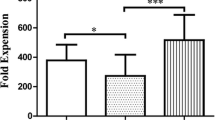Summary
The effect of mitomycin C administration on the generation of cytotoxic cells, induced by in vitro activation of peripheral blood mononuclear cells (PBM) with interleukin-2, was studied in patients with various carcinomas. The ability of PBM to generate lymphokine-activated killer (LAK) cell activity against Raji cell targets was significantly augmented 5 and 7 days after a single intravenous dose of 12 mg/m2 mitomycin C, when compared to that of PBM obtained before mitomycin C injection. Further, LAK cell activity against autologous tumor cells was also significantly increased after the drug administration. The distribution of lymphocyte subsets exhibited a significant increase in the percentage of CD3+ cells after injection, with the elevation of the CD4/CD8 ratio. Furthermore, the proportion of the CD4+ Leu8+ subpopulation, which identifies inducers of suppression, was significantly reduced. Thus, the decrease in the proportion of suppressor-inducer subsets of PBM might be at least partially, responsible for the augmented generation of LAK cells after mitomycin C administration.
Similar content being viewed by others
References
Akiyoshi T, Arinaga S, Tsuji H (1987) Augmentation of the generation of cell-mediated cytotoxicity in culture by mitomycin C. Cancer Immunol Immunother 24:256–262
Arinaga S, Akiyoshi T, Tsuji H (1986) Augmentation of the generation of cell-mediated cytotoxicity after a single dose of adriamycin in cancer patients. Cancer Res 46:4213–4216
Ben-Efrain S, Komlos L, Notmann J, Hart J, Halbrecht I (1985) In vitro selective effect of melphalan on human T-cell populations. Cancer Immunol Immunother 19:53–57
Berd D, Maguire HC, Mastrangelo MJ (1984) Impairment of concanavalin A-inducible suppressor activity following administration of cyclophosphamide to patients with advanced cancer. Cancer Res 44:1375–1380
Berd D, Mastrangelo MJ (1988) Effect of low dose cyclophosphamide on the immune system of cancer patients: depletion of CD4+, 2H4+ suppressor-inducer T-cells. Cancer Res 48:1671–1675
Damle NK, Mohagheghpour N, Engleman EG (1984) Soluble antigen-primed inducer T cells activate antigen-specific suppressor T cells in the absence of antigen-pulsed accessory cells: phenotype definition of suppressor-inducer and suppressor-effector cells. J Immunol 132:644–650
Damle NK, Doyle LV, Bradley EC (1986) Interleukin 2-activated human killer cells are derived from phenotypically heterogenous precursors. J Immunol 137:2814–2822
Ehrke MJ, Tomazic V, Ryoyama K, Cohen SA, Mihich E (1983) Adriamycin induced immunomodulation: dependence upon time of administration. Int J Immunopharmacol 5:43–48
Grimm EA, Mazumder A, Zhang HZ, Rosenberg SA (1982) Lymphokine-activated killer cell phenomenon. Lysis of natural killer-resistant fresh solid tumor cells by interleukin-2 activated autologous human peripheral blood lymphocytes. J Exp Med 155:1823–1841
Grimm EA, Vose BM, Chu EW, Wilson DJ, Lotze MT, Rayner AA, Rosenberg SA (1984) The human mixed lymphocyteumor cell interaction test. I. Positive autologous lymphocyte proliferative responses can be stimulated by tumor cells as well as by cells from normal tissues. Cancer Immunol Immunother 17:83–89
Grimm EA, Ramsey KM, Mazumder A, Wilson DJ, Djeu JY, Rosenberg SA (1985) Lymphokine-activated killer cell phenomenon. II. Precursor phenotype is serologically distinct from peripheral T lymphocytes, memory cytotoxic thymus-derived lymphocytes, and natural killer cells. J Exp Med 157:884–897
Hinuma S, Onda H, Naruo K, Ichimori Y, Koyama M, Tsukamoto K (1982) Translation of interleukin 2 mRNA from human peripheral blood leukocytes in Xenopus oocytes. Biochem Biophys Res Commun 109:363–369
Itoh K, Tilen AB, Kumagai K, Balch DM (1985) Leu-11+ lymphocytes with natural killer (NK) activity are precursors of recombinant interleukin 2 (rIL 2)-induced activated killer (AK) cells. J Immunol 134:802–807
Landy A, Gartland GL, Clement LT (1983) Characterization of phenotypically distinct subpopulation of Leu-2+ cells that suppresses T cell proliferative responses. J Immunol 131:2757–2761
Lotze MT, Chang AE, Seipp CA, Simpson C, Vetto JT, Rosenberg SA (1986) High-dose recombinant interleukin 2 in the treatment of patients with disseminated cancer: responses, treatment-related morbidity, and histologic findings. JAMA 256:3117–3124
Ogura T, Shindo H, Shinzato O, Namba M, Masuno T, Inoue T, Kishimoto S, Yamamura Y (1982) In vitro tumor cell killing by peritoneal macrophages from mitomycin C-treated rats. Cancer Immunol Immunother 13:112–117
Orsini F, Pavelic Z, Mihich E (1977) Increased primary cell-mediated immunity in culture subsequent to adriamycin or daunorubicin treatment of spleen donor mice. Cancer Res 37:1719–1726
Rosenberg SA, Lotze MT, Muul LM, Leitman S, Chang AE, Ettinghausen SE, Matory YL, Skibber JM, Shiloni E, Vetto JT, Seipp CA, Simpson C, Reichert CM (1985) Observations on the systemic administration of autologous lymphokine-activated killer cells and recombinant interleukin-2 to patients with metastatic cancer. N Engl J Med 313:1485–1492
Rosenberg SA, Lotze M, Muul LM, Chang AE, Avis FP, Leitman S, Linehan WM, Robertson CN, Lee RE, Rubin JT, Seipp CA, Simpson CG, White DE (1987) A progress report on the treatment of 157 patients with advanced cancer using lymphokine-activated killer cells and interleukin-2 or high-dose interleukin-2 alone. N Engl J Med 316:889–897
Shindo H, Ogura T, Masuno T, Hayashi S, Kishimoto S (1985) Induction of activated macrophages by intraperitoneal injection of mitomycin C in mice. Cancer Immunol Immunother 20:145–150
Stephan HI, Rittershaus CW, Healey KW, Struzziero CC, Hoffman RA, Hansen PW (1982) Rapid enumeration of T lymphocytes by a flow-cytometric immunofluorescence method. Clin Chem 28:1905–1910
Ting CC, Yang SS, Hargrove ME (1984) Induction of suppressor T-cells by interleukin 2. J Immunol 133:261–266
Ting CC, Yang SS, Hargrove ME (1986) Lymphokine-induced cytotoxicity: characterization of effectors, precursors, and regulatory ancillary cells. Cancer Res 46:513–518
Tomazic V, Ehrke MJ, Mihich E (1981) Augmentation of the development of immune responses of mice against allogeneic tumor cells after adriamycin treatment. Cancer Res 41:3370–3376
Author information
Authors and Affiliations
Rights and permissions
About this article
Cite this article
Nanbara, S., Arinaga, S. & Akiyoshi, T. Augmentation of the generation of lymphokine-activated killer cells after a single dose of mitomycin C in cancer patients. Cancer Immunol Immunother 29, 237–241 (1989). https://doi.org/10.1007/BF00199210
Received:
Accepted:
Issue Date:
DOI: https://doi.org/10.1007/BF00199210




